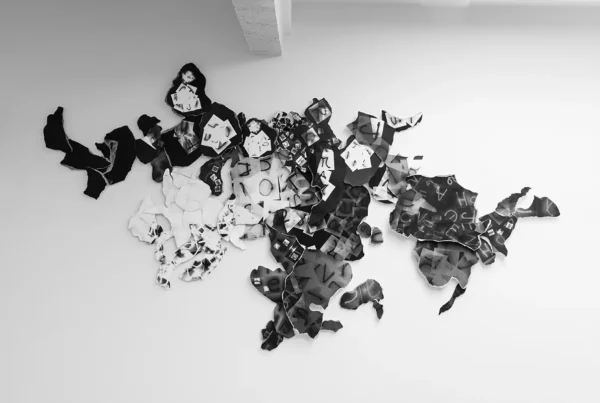“Photography is always a reflection of reality, but never an exact copy — that fragile connection is what I find truly captivating.”
Can you introduce yourself, share your background, and explain how it influences your artistic creations?
I am Evgeniya Strygina, a visual artist specialising in photography. Originally from Russia, I moved to the UK a few years ago, a transition that has profoundly shaped my perspective. My background — both cultural and personal — deeply influences my work, as I explore themes of identity, displacement, and belonging. Being born in a small town and currently living hundreds of miles away from it, I cannot help but wonder where I actually belong.
What inspired you to become an artist, and how did you get started in your career?
My mom’s been working in the production of black and white photographic paper for more than 40 years. It’s a technical process, and there was no creativity in it for me. No one ever told me it actually existed, but I sensed it did.
At university, I bought a DSLR camera and began experimenting with it, but I wasn’t interested in technical details like focal distance, exposure, aperture. To me, the camera was just a tool. What mattered was what I could say with it. Driven by the desire to develop my own vision, I enrolled at the Fine Art School of Photography in Moscow, where I took a course on visual perception. I learned to express feelings I’d always felt but never knew how to say, such as the metaphors in photography, the play of rhyme and rhythm, and finding the extraordinary in the ordinary. It changed how I approached my work: I started shooting in places I had previously avoided, thought more before pressing the shutter, and looked at the world from new perspectives. It was challenging, but growth always is.
After that, I took a year-long contemporary art course at the Moscow Museum of Modern Art. Studying art, especially in its contemporary form, was as easy as chasing your own tail if you’re a dog. It feels so close, happening right here and now, yet so mercurial that it doesn’t let you catch up. You can only snap your jaws as you try. It was an achingly good year. I realised that most of the ideas I’d just come up with had already been put into practice by someone else. It was another challenge and a way to evolve. I began creating and publicly presenting my projects, participating in group exhibitions, art fairs, and international festivals. Looking back, I see it as my artist’s origin story.

What’s your artistic style, and what themes do you explore?
At the start of my practice, I focused on landscapes and architecture, examining different spaces and offering visual interpretations of familiar scenes. I deconstructed the surrounding environment into its essential components, keeping my images almost or entirely uninhabited, where human figures, if present, are just one part of the world rather than its centre.
Currently, my work has shifted toward a more people-centred approach, blending documentary and staged photography. Yet, I maintain a strong connection to the environment, which is always meaningful in my work.
What elements do you need in your workspace, and how do you handle distractions?
My workspace is usually an empty, natural setting where I can be alone with my thoughts — or even without any thoughts at all. When a photo shoot involves people, it never takes place in a studio. I don’t like artificial environments created by someone else, so I often photograph in an environment that holds personal significance for the subject.

Who are your biggest artistic influences?
I tend to answer this question differently every time, because my influences keep shifting. Sometimes it’s a particular artist or exhibition, other times it’s a book, a film, or even a conversation that stays with me. In the beginning, I was drawn to artists like Hiroshi Sugimoto and Andreas Gursky. I found a sense of visual calm in the sculptures of Giacometti and Alexander Calder. I admire how Grayson Perry addresses current issues in a very subtle way. I also spend a lot of time looking at contemporary photography, though I prefer not to name specific artists — I’m more interested in the variety of approaches and ways of seeing. Studying at PHmuseum under curator Erik Kessels was also an important influence on my practice.
Can you discuss a specific piece of artwork that holds special meaning to you, and why it is significant?
One of the works that’s most meaningful to me is the series “Home from Home,” which explores the complex feelings of belonging and displacement. This project is deeply personal as it reflects my journey and the emotions tied to leaving the familiar and gradually piecing life together somewhere new.

How did you choose your preferred medium, and have you tried other mediums?
I have two early memories of photography. The first involves looking at photographs taken by someone else. I found them in a family photo album full of black-and-white snapshots—many faces I didn’t recognise, distant relatives and friends of friends whose names I didn’t know. These images felt like fragments of a distant past, capturing moments I wasn’t part of but which held meaning for my family.
The second memory is more personal: photographs I took myself. I remember the excitement of waiting for a roll of film to be developed. What fascinated me back then was that photography is always a reflection of reality, but never an exact copy. It’s that fragile connection to the real world — and the opportunity to create your own version of it — that I find truly captivating.
My approach to photography is exploratory. Initially, it was about orienting myself within the landscape, trying to grasp its essence, capturing my impressions, and creating a new visual reality. However, I’ve started to feel confined by this kind of fixation. So, I’ve shifted from exploring the external to focusing more on the internal — what specifically moves me, what I want to talk about, what I love, and what I hate. This introspection is now a step I take before starting a project.
Now, my practice also involves working with text and personal archives, allowing me to create more complex projects that explore memory, identity, and narrative in greater depth — blurring the lines between documentation and interpretation.
Is there a particular project idea that you’ve been dreaming to turn into reality?
Yes, there is a project I’ve been thinking about for a long time. It’s connected to the loss of someone very close to me last year. I’m not sure yet if or when it will take shape, but it’s something that stays with me.
This idea also reflects a broader shift in my work: in recent years, pain has become a source of inspiration. Personal experiences and difficult changes have led me to create more intimate, reflective projects. In that sense, art has become both a form of self-therapy and a way to process what I’m going through.






